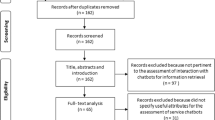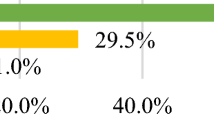Abstract
The fluency of animation is deemed to significantly influence user experience. However, there is no effective tool to evaluate users’ experience of smartphone animation fluency. The current research aims to develop and verify a smartphone animation fluency evaluation scale through 3 studies. Study 1 collected users’ evaluations of and suggestions about smartphone animation and extracted 4 evaluation dimensions of smartphone animation fluency: rationality, consistency, quality, and promptness. Study 2 and Study 3 developed fluency evaluation scales for clicking and switching animation, respectively, and examined the construct validity of the scales by exploratory factor analysis and confirmatory factor analysis. Through the analysis of 1424 data points, the results showed that the smartphone animation fluency evaluation scale has great reliability and validity, and the dimension of animation fluency can significantly predict users’ overall attitudes towards smartphone animation. Finally, based on the results of the above three studies, we propose a smartphone animation fluency evaluation model (named the FAIE model) containing four dimensions: function value, aesthetic value, interactive value, and emotional value. The development of a smartphone animation fluency evaluation scale can be used for enterprises to design and evaluate animation fluency to improve users’ satisfaction with products.

Similar content being viewed by others
Data availability
The datasets generated during and analysed during the current study are not publicly available but are available from the corresponding author on reasonable request. Please email the author to get data and material.
References
Agarwal, A., & Meyer, A. (2009). Beyond usability: evaluating emotional response as an integral part of the user experience. In CHI'09 Extended Abstracts on Human Factors in Computing Systems (pp. 2919–2930).
Avila-Munoz, R., Clemente-Mediavilla, J., & Perez-Luque-Maricalva, M. J. (2021). Communicative functions in human-computer Interface design: A taxonomy of functional animation. Review of Communication Research, 9, 119–146. https://rcommunicationr.org/index.php/rcr/article/view/99. Accessed 31 Oct 2022.
Baecker, R., & Small, I. (1990). Animation at the interface. In L. Brenda (ed.), The Art of Human-Computer Interface Design. Addison-Wesley Longman Publishing Co., Inc. (pp. 251–267).
Branaghan, R. J., & Sanchez, C. A. (2009). Feedback preferences and impressions of waiting. Human Factors, 51(4), 528.
Bryman, A., & Cramer, D. (2002). Quantative Data Analysis with SPSS Release 10 for Windows. A Guide for Social Scientists. Quantative Data Analysis with SPSS Release 10 for Windows. A Guide for Social Scientists.
Cnattingius, L. (2021). Analyzing the effect of animated transitions on the user experience of mobile interfaces (Dissertation). Retrieved from http://urn.kb.se/resolve?urn=urn:nbn:se:kth:diva-301641
Desmet, P. M. A., & Hekkert, P. (2007). Framework of product experience. International Journal of Design, 1(1), 57–66.
Dessart, C.-E., Genaro Motti, V., & Vanderdonckt, J. (2011). Showing user interface adaptivity by animated transitions. Proceedings of the 3rd ACM SIGCHI symposium on Engineering interactive computing systems.
Doherty, R. A., & Sorenson, P. (2015). Keeping users in the flow: Mapping system responsiveness with user experience. Procedia Manufacturing, 3, 4384–4391.
Fisher, N. I., & Kordupleski, R. E. (2019). Good and bad market research: A critical review of net promoter score. Applied Stochastic Models in Business and Industry, 35(1), 138–151. https://doi.org/10.1002/asmb.2417
Gaur, V., & Scassellati, B. (2006). Which motion features induce the perception of animacy. Proc. 2006 IEEE International Conference for Development and Learning, Bloomington, Indiana.
Ghadiyaram, D., Bovik, A. C., Yeganeh, H., Kordasiewicz, R., & Gallant, M. (2015). Study of the effects of stalling events on the quality of experience of mobile streaming videos. 2014 IEEE Global Conference on Signal and Information Processing (GlobalSIP).
Ghadiyaram, D., Pan, J., & Bovik, A. C. (2017). A subjective and objective study of stalling events in mobile streaming videos. IEEE Transactions on Circuits and Systems for Video Technology, 29(1), 183–197.
Harrison, C., Amento, B., Kuznetsov, S., & Bell, R. (2007). Rethinking the progress bar. Proceedings of the 20th annual ACM symposium on User interface software and technology.
Huhtala, J., Sarjanoja, A. H., Mntyjrvi, J., Isomursu, M., & Hkkil, J. (2010). Animated UI transitions and perception of time: A user study on animated effects on a mobile screen. Sigchi Conference on Human Factors in Computing Systems.
Igbaria, M., Schiffman, S. J., & Wieckowski, T. J. (1994). The respective roles of perceived usefulness and perceived fun in the acceptance of microcomputer technology. Behaviour & Information Technology, 13(6), 349–361.
Ijari, K. (2019). Understanding the Effect of Animation and its Speed on User Enjoyment. Arizona State University.
Kaaresoja, T., Brewster, S., & Lantz, V. (2014). Towards the temporally perfect virtual button: Touch-feedback simultaneity and perceived quality in mobile touchscreen press interactions. ACM Transactions on Applied Perception (TAP), 11(2), 1–25.
Kalac, E., Borovina, N., & Boskovic, D. (2021). Preserving interaction design principles while implementing Material Design Guidelines. 2021 20th International Symposium INFOTEH-JAHORINA (INFOTEH).
Kang, H., Hahn, M., Fortin, D. R., Hyun, Y. J., & Eom, Y. (2006). Effects of perceived behavioral control on the consumer usage intention of e-coupons. Psychology & Marketing, 23(10), 841–864. https://doi.org/10.1002/mar.20136
Khan, S. N., & Mohsin, M. (2017). The power of emotional value: Exploring the effects of values on green product consumer choice behavior. Journal of Cleaner Production, 150, 65–74.
Kim, S., Yoon, M., Whang, S.-M., Tversky, B., & Morrison, J. B. (2007). The effect of animation on comprehension and interest. Journal of Computer Assisted Learning, 23(3), 260–270. https://doi.org/10.1111/j.1365-2729.2006.00219.x
Laugwitz, B., Held, T., & Schrepp, M. (2008). Construction and evaluation of a user experience questionnaire. Symposium of the Workgroup Human-computer Interaction & Usability Engineering of the Austrian Computer Society on Hci & Usability for Education & Work.
Li, J. W. (2015). Evaluation system research and implementation of the smart phone user experience. Beijing University of Posts and Telecommunications.
Li, W., Zhang, X., & Zhang, Y. S. (2018a). How animation improve Children’s cognition in user Interface: A study of the kids VOD application. Design, User Experience, and Usability: Users, Contexts and Case Studies.
Li, Y., Tang, D., Tao, T., Guo, N., Li, S., Zhang, Z., & Yang, X. (2018b). The Impact of Tourism Product Harm Crisis Attribute on Travel Intention. 8th International Conference on Education, Management, Information and Management Society (EMIM 2018).
Liu, X., Qu, W., Wang, C., Zhang, Q., & Ge, Y. (2021). A Survey Study of Factors Influencing Smart Phone Fluency. International Conference on Human-Computer Interaction.
Merz, B., Tuch, A. N., & Opwis, K. (2016). Perceived user experience of animated transitions in mobile user interfaces. Proceedings of the 2016 CHI Conference Extended Abstracts on Human Factors in Computing Systems.
Mew, K. (2015). Learning Material Design: Master Material Design and Create Beautiful, Animated Interfaces for Mobile and Web Applications. Packt Publishing, Limited. http://psych.summon.serialssolutions.com/2.0.0/link/0/eLvHCXMwtV1LS8NAEB6quQhCfVKf5OQtZZNs9nGStjYUQRCUeiy72Y3ooVaJ_9_ZZLcWPXjyliVLYF_ffpP5ZgYgz4Yk-YEJkmtTUS4MJVooRignBp8KZriSnciyvC9mt6x8kg89WGcrcEzTqxSHASrXrtSXt5UXWg67IIBr0wIzLTLCeXq1ek9cdSnnhfWlNrYgcvc5nodoNBqP52HnoZ3mPGD5RjsX7DuxGr7jMhD91y7pjECscJFiXBRotIg0JJAK7fQXurdXVtn_t9HtQWRdhMQ-9OzyAPqhLkTsYeIQBj5p63N8p5p2h8c3rVDkCObl9HEyS3wFhkTleLPlic6zSkqjbSZxwZh1XlRCayR9eHRrWacWKYrkFWVUF4ZYWtSyqoitVY12Cxrqx7CrnFR_2bQhfWYAMU8rV-6DG-Y-JbgmmeI1R7KniLFanEAcJmOxOUWL6XjiB3_6d5cz2EFuU3R_S85hu_n4tBcQtRryS7_8X9y0waU. Accessed 31 Oct 2022.
Mumcu, Y., & Kimzan, H. S. (2015). The effect of visual product aesthetics on consumers’ Price sensitivity. Procedia Economics and Finance, 26, 528–534. https://doi.org/10.1016/S2212-5671(15)00883-7
Novick, D., Rhodes, J., & Wert, W. (2011). The communicative functions of animation in user interfaces. Proceedings of the 29th ACM international conference on Design of communication.
Parovel, G., Guidi, S., & Kreß, K. (2018). Different contexts change the impression of animacy. Attention, Perception, & Psychophysics, 80(2), 553–563.
Reber, R., Schwarz, N., & Winkielman, P. (2004). Processing fluency and aesthetic pleasure: Is beauty in the Perceiver's processing experience? Personality and Social Psychology Review, 8(4), 364–382. https://doi.org/10.1207/s15327957pspr0804_3
Reichheld, F. F. (2003). The one number you need to grow. Harvard Business Review, 81(12), 46–55.
Sheth, J. N., Newman, B. I., & Gross, B. L. (1991). Why we buy what we buy: A theory of consumption values. Journal of Business Research, 22(2), 159–170.
Tan, Z., Zhu, J., Chen, J., & Li, F. (2018). The effects of response time on user perception in smartphone interaction. In International Conference on Applied Human Factors and Ergonomics (pp. 342–353). Springer.
Thomas, B. H., & Calder, P. (2001). Applying cartoon animation techniques to graphical user interfaces. ACM Transactions on Computer-Human Interaction (TOCHI), 8(3), 198–222.
Tractinsky, N., Katz, A. S., & Ikar, D. J. I. W. C. (2000). What is beautiful is usable., 13(2), 127–145.
Tsiotsou, R. (2006). The role of perceived product quality and overall satisfaction on purchase intentions. International Journal of Consumer Studies, 30(2), 207–217.
Turel, O., Serenko, A., & Bontis, N. (2010). User acceptance of hedonic digital artifacts: A theory of consumption values perspective. Information & Management, 47(1), 53–59. https://doi.org/10.1016/j.im.2009.10.002
Tversky, B., Morrison, J. B., & Betrancourt, M. (2002). Animation: Can it facilitate? International Journal of Human-Computer Studies, 57(4), 247–262.
Van Rompay, T. J., De Vries, P. W., Bontekoe, F., & Tanja‐Dijkstra, K. (2012). Embodied product perception: Effects of verticality cues in advertising and packaging design on consumer impressions and price expectations. Psychology & Marketing, 29(12), 919–928.
Wu, Z., Jiang, Y., Liu, Y., & Ma, X. (2020). Predicting and diagnosing user engagement with Mobile UI animation via a data-driven approach. Chi, 20, 1–13. https://doi.org/10.1145/3313831.3376324
Yang, H.-L., & Lin, R.-X. (2017). Determinants of the intention to continue use of SoLoMo services: Consumption values and the moderating effects of overloads. Computers in Human Behavior, 73, 583–595.
Yeganeh, H., Hamid, F. Q., & Rabiee, R. (2017). Joint Effect of Stalling and Presentation Quality on the Quality-of-Experience of Streaming Videos. IEEE Conference on Image Processing (ICIP).
Yin, N. (2018). The influencing outcomes of job engagement: an interpretation from the social exchange theory. International Journal of Productivity and Performance Management, 67(5), 873–889. https://doi.org/10.1108/IJPPM-03-2017-0054
Zhang, Z., & Zheng, L. (2021). Consumer community cognition, brand loyalty, and behaviour intentions within online publishing communities: An empirical study of Epubit in China. Learned Publishing, 34(2), 116–127.
Zhou, R., Shao, S., Li, W., & Zhou, L. (2016). How to define the user's tolerance of response time in using mobile applications. 2016 IEEE International Conference on Industrial Engineering and Engineering Management (IEEM) (pp. 281–285). https://doi.org/10.1109/IEEM.2016.7797881
Author information
Authors and Affiliations
Contributions
Conceived and designed the experiments: YZ, WQ and YG. Performed the experiments: YW. Analyzed the data: XL and YW. Drafted the manuscript: XL and YG.
Corresponding author
Ethics declarations
The authors declare that they have no known competing financial interests or personal relationships that could have appeared to influence the work reported in this paper.
Additional information
Publisher’s note
Springer Nature remains neutral with regard to jurisdictional claims in published maps and institutional affiliations.
Rights and permissions
Springer Nature or its licensor (e.g. a society or other partner) holds exclusive rights to this article under a publishing agreement with the author(s) or other rightsholder(s); author self-archiving of the accepted manuscript version of this article is solely governed by the terms of such publishing agreement and applicable law.
About this article
Cite this article
Liu, X., Zhang, Y., Wang, Y. et al. The development of a smartphone animation fluency evaluation scale based on qualitative and quantitative research. Curr Psychol 42, 31987–31997 (2023). https://doi.org/10.1007/s12144-022-04198-1
Accepted:
Published:
Issue Date:
DOI: https://doi.org/10.1007/s12144-022-04198-1




